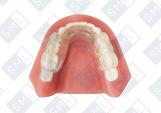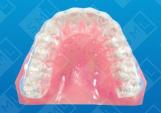
Splints
Occlusal splints are removable appliances that are usually made of hard acrylic and fit over the occlusal surface of either the maxillary or mandibular dentition. The goal? To create a precise occlusal relationship with the teeth of the opposing arch. These appliances are some of the most versatile tools used in dentistry. A properly designed splint can:
- break up doodling patterns and cover any facets of wear
- protect the teeth from abnormal forces that may create a tooth fracture or breakage of restorations
- protect the bony and soft tissue supportive structures against abnormal forces that would cause their breakdown
- introduce an optimum occlusal position
- deprogram the musculature and reorganize neuromuscular reflex activity
- encourage normal muscle function
- alleviate any occlusal stresses to the posterior teeth by providing anterior guidance
- establish a new vertical relationship
- alleviate occlusal stresses to the anterior teeth by controlling the vertical dimension
- provide the teeth with protection from diurnal and nocturnal bruxism
- provide a core stable or functional join position
As our society becomes more complex, the incidence of bruxism and temporomandibular joint (TMJ) dysfunction seems to be on the increase. Nocturnal bruxism may be the most destructive form, because the patient is potentially unaware of the habit until it is too late. TMJ dysfunction is an extremely complex problem that effects a large percentage of the population. Although a wide variety of treatment approaches and appliance designs are available for the treatment of these disorders, the most common appliance is a splint. A splint can protect the patient against the destructive forces of nocturnal bruxism and act as a diagnostic treatment tool in the management of temporomandibular joint dysfunction. Regardless of the treatment technique, early intervention can prevent many of the severe problems associated with bruxism and TMJ dysfunction.
Whether you're treating a bruxism problem or a joint disorder, splint therapy is almost always your first line of defense. This is because splints are generally reversible, non-invasive and very effective at reducing symptoms. In addition, splints are an excellent diagnostic tool, as their very presence can alter some of the etiologic factors of TMJ dysfunction.
Select another Appliance Category






























